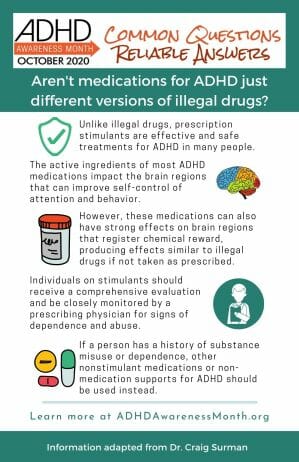The active ingredients of most medications that work for ADHD, including the stimulants methylphenidate and amphetamine salts, are thought to impact levels of norepinephrine and dopamine in brain regions that can improve self-control of attention and behavior. However, they also have strong effects on brain regions that register chemical reward, which is thought to be why ADHD prescriptions can produce effects similar to those of illegal drugs, particularly when they are taken into the body more quickly than they are designed to be delivered for ADHD treatment. In addition, some individuals may have atypical side effects or other reactions to taking these medications that lead to problematic use patterns, including tolerance – wherein they have less effect over time.
All individuals receiving stimulants should be monitored for signs of dependence and abuse. A comprehensive evaluation and close monitoring by a prescribing physician is thought to increase the chance of identifying problems before or as they emerge. If a person has a history of substance misuse or dependence, there may be a higher risk that ADHD medications will be misused or abused – and other nonstimulant medications or non-medication supports for ADHD should be used instead.
About the Author

Dr. Craig Surman is Associate Professor of Psychiatry at Harvard Medical School. He is the Scientific Coordinator of the Adult ADHD Research Program at Massachusetts General Hospital, one of the largest research programs of its kind in the world. Dr. Surman has directed or facilitated over fifty studies related to ADHD in adults, and co-authored many articles in peer-reviewed publications.
References
- Swanson, Wigal and Volkow 2011. Contrast of Medical and Nonmedical Use of Stimulant Drugs, Basis for the Distinction, and Risk of Addiction: Comment on Smith and Farah (2011). Psychological Bulletin 2011, Vol. 137(5). https://www.ncbi.nlm.nih.gov/pmc/articles/PMC3187625/
- Cassidy, Varughese, Russo, Budman, Eaton, and Butler. Nonmedical Use and Diversion of ADHD Stimulants Among U.S. Adults Ages 18-49: A National Internet Survey. Journal of Attention Disorders 2015, Vol. 19(7). https://pubmed.ncbi.nlm.nih.gov/23269194/

